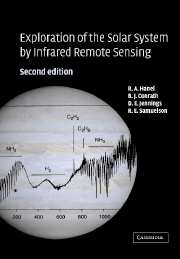Book contents
- Frontmatter
- Contents
- Introduction to first edition
- Introduction to second edition
- 1 Foundation of radiation theory
- 2 Radiative transfer
- 3 Interaction of radiation with matter
- 4 The emerging radiation field
- 5 Instruments to measure the radiation field
- 6 Measured radiation from planetary objects up to Neptune
- 7 Trans-Neptunian objects and asteroids
- 8 Retrieval of physical parameters from measurements
- 9 Interpretation of results
- Closing remarks
- Appendices
- References
- Abbreviations
- Index
4 - The emerging radiation field
Published online by Cambridge University Press: 07 September 2009
- Frontmatter
- Contents
- Introduction to first edition
- Introduction to second edition
- 1 Foundation of radiation theory
- 2 Radiative transfer
- 3 Interaction of radiation with matter
- 4 The emerging radiation field
- 5 Instruments to measure the radiation field
- 6 Measured radiation from planetary objects up to Neptune
- 7 Trans-Neptunian objects and asteroids
- 8 Retrieval of physical parameters from measurements
- 9 Interpretation of results
- Closing remarks
- Appendices
- References
- Abbreviations
- Index
Summary
The last chapter dealt with the interaction of radiation with matter, mostly in the gaseous, but also in the liquid and solid phases. Absorption coefficients of infrared active gases, emission and scattering properties of surfaces, and single scattering albedos and phase functions of aerosols were considered. Applications of these concepts, along with the principles of radiative transfer discussed in Chapter 2, enable us to calculate the emerging radiation field of a planet or satellite.
In this chapter we examine how the physical state of an emitting medium gives rise to the general spectral characteristics of the outgoing radiation field. We begin in Section 4.1 by considering the behavior of a single spectral line in an isothermal atmosphere, both with and without scattering. In Section 4.2 we introduce nonscattering atmospheric models having a more complicated thermal structure, but still consider only a single line. Finally, in Section 4.3 we conclude our investigation of nonscattering models using realistic molecular parameters. Our aim in this chapter is to illustrate the principles behind the analysis of remotely sensed data, especially with regard to how scattering, atmospheric abundances, and thermal structures affect the appearance of the observed spectrum. Later, in Chapter 6, we apply these principles to the descriptions of real planetary spectra.
Models with one isothermal layer
Without scattering
The first model considered consists of a nonscattering gas layer at constant pressure and temperature adjacent to a solid surface of unit emissivity. This model is illustrated in Fig. 4.1.1.
- Type
- Chapter
- Information
- Exploration of the Solar System by Infrared Remote Sensing , pp. 129 - 151Publisher: Cambridge University PressPrint publication year: 2003



